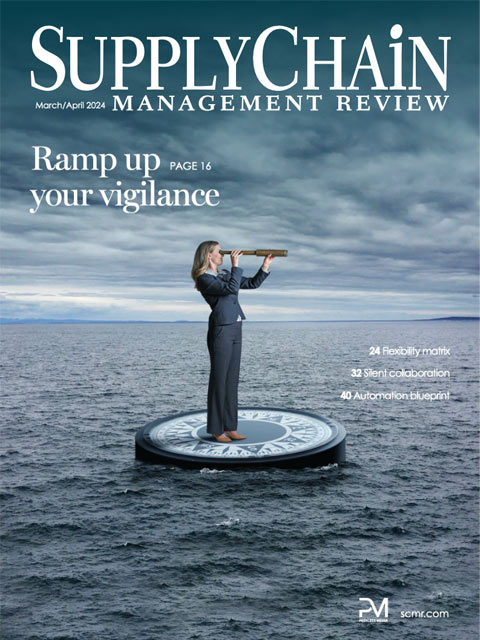Sorry, but your login has failed. Please recheck your login information and resubmit. If your subscription has expired, renew here.
March-April 2024
Part of any supply chain manager’s job is risk mitigation. Thanks to COVID-19 and the ensuing, and constant, disruptions that have followed, more companies are now focused on reducing their exposure to supply chain chaos. We’ve heard a lot about diversification in recent years—having multiple suppliers in multiple locations. But risk mitigation goes far beyond diversification, and the recent case of Boeing should serve as a cautionary tale not to avoid those other risks. Browse this issue archive.Need Help? Contact customer service 847-559-7581 More options
Mobility and industrial products executives are navigating the continuation and amplification of supply chain’s disruptive forces: geopolitical unrest, labor shortages and reduced knowledge/skillsets, supply ebbs and tides, rising costs, shifting consumer expectations, and rapid technology advances. Supply chain strategies play a central role in responding to these challenges. For 2024, three specific supply chain initiatives will help executives control spend, mitigate labor shortages, meet consumer expectations, and advance their companies’ resilience and competitive edge. Three critical initiatives companies must embrace are visibility, business continuity, and network optimization.
Visibility and control: The backbone transforming supply chains into optimized supply networks
Technology is generating data at an unprecedented pace—algorithmically. The advances in artificial intelligence (AI) are weaponizing the supply network with robotic process automation and detailed cognitive analytics at the direct-to-consumer behavior level. As a mobility and industrial products executive, you are challenged to ask whether the data you are receiving is the right data for your company and in a form you can use to make insightful, predictive decisions quickly. Do you know the origins of the data? How can you integrate it with your operations systems? How can you leverage the data for process improvement and competitive advantage? What is the value to be created? Do you trust the data? What opportunities are you looking for? What are the cyber risks and data liabilities? So many questions, so few answers.
Two factors will determine the quality of the answers to these questions: the maturity of your planning, procurement, operations, and logistics; and the level of visibility available and applicable to you.

This complete article is available to subscribers only.
Log in now for full access or start your PLUS+ subscription for instant access.
SC
MR
Sorry, but your login has failed. Please recheck your login information and resubmit. If your subscription has expired, renew here.
March-April 2024
Part of any supply chain manager’s job is risk mitigation. Thanks to COVID-19 and the ensuing, and constant, disruptions that have followed, more companies are now focused on reducing their exposure to supply chain… Browse this issue archive. Access your online digital edition. Download a PDF file of the March-April 2024 issue.Mobility and industrial products executives are navigating the continuation and amplification of supply chain’s disruptive forces: geopolitical unrest, labor shortages and reduced knowledge/skillsets, supply ebbs and tides, rising costs, shifting consumer expectations, and rapid technology advances. Supply chain strategies play a central role in responding to these challenges. For 2024, three specific supply chain initiatives will help executives control spend, mitigate labor shortages, meet consumer expectations, and advance their companies’ resilience and competitive edge. Three critical initiatives companies must embrace are visibility, business continuity, and network optimization.
Visibility and control: The backbone transforming supply chains into optimized supply networks
Technology is generating data at an unprecedented pace—algorithmically. The advances in artificial intelligence (AI) are weaponizing the supply network with robotic process automation and detailed cognitive analytics at the direct-to-consumer behavior level. As a mobility and industrial products executive, you are challenged to ask whether the data you are receiving is the right data for your company and in a form you can use to make insightful, predictive decisions quickly. Do you know the origins of the data? How can you integrate it with your operations systems? How can you leverage the data for process improvement and competitive advantage? What is the value to be created? Do you trust the data? What opportunities are you looking for? What are the cyber risks and data liabilities? So many questions, so few answers.
Two factors will determine the quality of the answers to these questions: the maturity of your planning, procurement, operations, and logistics; and the level of visibility available and applicable to you.
SC
MR


Latest Supply Chain News
Latest Podcast

 Explore
Explore
Business Management News
- U.S.-bound containerized import shipments are up in June and first half of 2024
- Expand supply chain metrics to cover the complete customer experience
- When disaster strikes, the supply chain becomes the key to life
- Leadership development for supply chain leaders
- A smarter approach to sustainability is vital for healthy, resilient supply chains
- When the scales tilt: Making vaccine access work for all
- More Business Management
Latest Business Management Resources

Subscribe

Supply Chain Management Review delivers the best industry content.

Editors’ Picks





